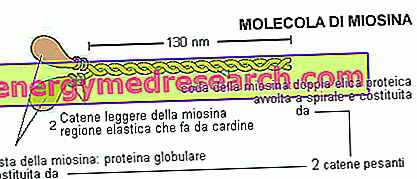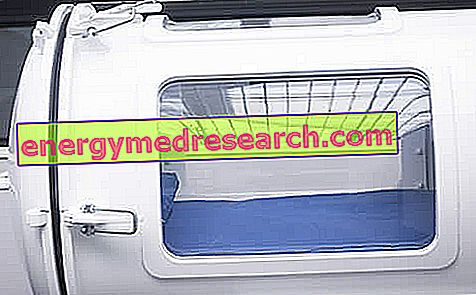Myosin
Myosin is the motor of myofibrils; each molecule consists of 6 subunits, of which 2 identical heavy chains, very large, and two pairs of smaller light chains.
The heavy protein chains intertwine to form a terminal tail, rigid, spiral, and two globose heads.
Two light protein chains are associated with the heavy chains of each head.

Within the thick filaments, the various isoforms of the myosin organize themselves in such a way as to expose their heads to the extremity, while the tails are grouped, by way of a bundle, in the central region. The junction between head and tail is a flexible neck (hinge) that allows the heads to flex during contraction.
The globular portion is also referred to as heavy meromiosin, while the terminal portion is known as light meromiosin.
The myosine globular heads form the transverse bridges that mediate the interaction with the thin filaments of actin, which act as a "rope".
The phenomenon of contraction can be divided into two phases:
1) coupling (formation of cross bridges) between thick and thin filaments;
2) filament sliding
As mentioned, the formation of cross bridges depends on the increase in the activity of calcium inside the fiber. The presence in the head of myosin of a pocket assigned to the binding with the ATP is also fundamental, as well as of an enzyme (ATPase) able to break it down into ADP and inorganic phosphate, releasing energy.
Actin
Actin, which forms the fine strands of the sarcomere, is a globular protein, similar in shape to a sphere (G-actin). Many of these molecules are associated with each other to compose long and thin granules (called F-actin). Two of these chains wrap themselves one above the other like two pearl necklaces, giving rise to the thin filament.
Each G-actin molecule contains a binding site for the myosin head, which, in resting conditions, is actually blocked by two proteins. The thin filaments are in fact constituted not only by actin but also by:
- TROPOMIOSIN: in resting muscle it prevents contact between 7 G-actin molecules and their respective myosin heads, keeping the muscle relaxed.
- TROPONINE: when it binds calcium it changes its conformation and moves the tropomyosin allowing the coupling with myosin

In addition to these proteins, muscle myofibrils contain others, including:
titin, connectin and nebulin, with function of stabilization and centering of the sarcomere during the contraction.



